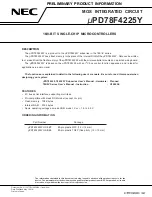
Instruction Manual
D200126X012
2502 Controllers
June 2017
6
Caged sensors will be shipped with the displacer installed in the cage. If the sensor is ordered with a tubular gauge
glass, the gauge glass will be crated separately and must be installed at the site. Be certain that the cage equalizing
connections are not plugged with foreign material.
A caged sensor has a damping plate installed in the lower screwed or flanged connection to provide more stable
operation. If the process liquid could clog the plate opening with sediment, then remove the damping plate. For
screwed connections, use a 1/2‐inch hexagon wrench to unscrew the damping plate. For flanged connections, use a
screwdriver to pry the damping plate out of the flange.
A cageless sensor is shipped with the displacer separated from the sensor assembly. A displacer longer than 813 mm
(32 inches) is crated separately. A shorter displacer is crated with the sensor, but is not attached to the displacer rod.
Inspect the displacer and replace if it is dented. A dent may reduce the pressure rating of the displacer.
Controller Orientation
A controller is to be mounted with the vent opening pointing downward as shown in figure 3. This orientation is
necessary to ensure draining of accumulated moisture. The controller is attached to the sensor in one or the other of
the mounting positions shown in figure 4: Right hand (with the case to the right of the displacer when looking at the
front of the case) or left hand (with the case to the left of the displacer). The mounting position can be changed in the
field if required; refer to the appropriate sensor manual for instructions. Changing this mounting position will change
controller action from direct to reverse, or vice versa.
Figure 3. Pressure Connections
1/4‐18 NPT
SUPPLY CONNECTION
ADJUSTING
SCREW
DRAIN VALVE
LOCKNUT
1/4‐18 NPT
OUTPUT CONNECTION
VENT
PRESSURE REGULATOR
All caged sensors have a rotatable head. That is, the controller may be positioned at any of eight alternate positions
around the cage as indicated by the numbers 1 through 8 in figure 4. To rotate the head, remove the head flange bolts
and nuts and position the head as desired.
Controller‐Sensor Action
The following controller description is for right‐hand mounting. Left‐hand mounting produces an output signal with
the opposite action. Figure 4 shows cage head mounting positions.
For right‐hand mounting:
D
Direct Action—Increasing liquid or interface level, or density, increases the output signal.
D
Reverse Action—Decreasing liquid or interface level, or density, increases the output signal. A factory‐supplied
reverse‐acting unit has the suffix letter R added to the type number.







































